
List of shahenshahs of the Sassanid Empire
Encyclopedia
The Shahenshahs of the Sassanid Empire ruled over a vast majority of land, even continuing its role as a superpower in Asia. The Sassanid dynasty began with Ardeshir I in 224 and was destroyed with Yazdegerd III in 651. The downfall of the Sassanid Empire proved great significance and effects to Zoroastrianism
, the state religion of the Sassanid Empire. The previous Zoroastrian shahenshahs were replaced with Muslim Caliphs who forced the Zoroastrians and their faith
to endure harsh conditions, including the destruction of fire temples throughout the previous Sassanid Empire and marginalization of the faith.
In the Sasanid era, the term "the king of kings of Iran" (Middle Persian
: šāhān šāh Ērān; En.
Shahenshahs) was used from the time of its establishment by Ardashir. The term "king of kings of Iran" appears in Sasanid documents. In Kabe Zartosht inscription of Shapur I the Great the titles are chosen in a precise manner. In that Shapur names four of his Sasanid predecessors with different titles and in "an ascending order of importance" by giving the title (Xwaday) "the lord" to Sasan, "the king
" to Papag, "the King of kings of Iran
" to Ardashir, and "king of kings of Iran and non-Iran
" to himself. .
Throughout its existence, the Sassanid Empire had been an absolute monarchy
. The Shahenshah was the height of authority, with satraps ruling over their satrapies underneath them. Shahenshah's being the highest form of authority throughout the empire often had rebellions from their satraps from different satrapies. In fact, the Sassanid Empire had been founded on a rebellion towards the Parthian Empire
from a satrapie.
Zoroastrianism
Zoroastrianism is a religion and philosophy based on the teachings of prophet Zoroaster and was formerly among the world's largest religions. It was probably founded some time before the 6th century BCE in Greater Iran.In Zoroastrianism, the Creator Ahura Mazda is all good, and no evil...
, the state religion of the Sassanid Empire. The previous Zoroastrian shahenshahs were replaced with Muslim Caliphs who forced the Zoroastrians and their faith
Zoroastrianism
Zoroastrianism is a religion and philosophy based on the teachings of prophet Zoroaster and was formerly among the world's largest religions. It was probably founded some time before the 6th century BCE in Greater Iran.In Zoroastrianism, the Creator Ahura Mazda is all good, and no evil...
to endure harsh conditions, including the destruction of fire temples throughout the previous Sassanid Empire and marginalization of the faith.
In the Sasanid era, the term "the king of kings of Iran" (Middle Persian
Middle Persian
Middle Persian , indigenously known as "Pârsig" sometimes referred to as Pahlavi or Pehlevi, is the Middle Iranian language/ethnolect of Southwestern Iran that during Sassanid times became a prestige dialect and so came to be spoken in other regions as well. Middle Persian is classified as a...
: šāhān šāh Ērān; En.
Transliteration
Transliteration is a subset of the science of hermeneutics. It is a form of translation, and is the practice of converting a text from one script into another...
Shahenshahs) was used from the time of its establishment by Ardashir. The term "king of kings of Iran" appears in Sasanid documents. In Kabe Zartosht inscription of Shapur I the Great the titles are chosen in a precise manner. In that Shapur names four of his Sasanid predecessors with different titles and in "an ascending order of importance" by giving the title (Xwaday) "the lord" to Sasan, "the king
Shah
Shāh is the title of the ruler of certain Southwest Asian and Central Asian countries, especially Persia , and derives from the Persian word shah, meaning "king".-History:...
" to Papag, "the King of kings of Iran
Sassanid Empire
The Sassanid Empire , known to its inhabitants as Ērānshahr and Ērān in Middle Persian and resulting in the New Persian terms Iranshahr and Iran , was the last pre-Islamic Persian Empire, ruled by the Sasanian Dynasty from 224 to 651...
" to Ardashir, and "king of kings of Iran and non-Iran
Aniran
Anīrān or Anērān is an ethno-linguistic term that signifies "non-Iranian" or "non-Iran." Thus, in a general sense, 'Aniran' signifies lands where Iranian languages are not spoken...
" to himself. .
Throughout its existence, the Sassanid Empire had been an absolute monarchy
Absolute monarchy
Absolute monarchy is a monarchical form of government in which the monarch exercises ultimate governing authority as head of state and head of government, his or her power not being limited by a constitution or by the law. An absolute monarch thus wields unrestricted political power over the...
. The Shahenshah was the height of authority, with satraps ruling over their satrapies underneath them. Shahenshah's being the highest form of authority throughout the empire often had rebellions from their satraps from different satrapies. In fact, the Sassanid Empire had been founded on a rebellion towards the Parthian Empire
Parthian Empire
The Parthian Empire , also known as the Arsacid Empire , was a major Iranian political and cultural power in ancient Persia...
from a satrapie.
| # | Shahenshah | Coin or statue | Reigned from | Reigned until | Relationship to Predecessor | Notes | |||||
|---|---|---|---|---|---|---|---|---|---|---|---|
| 1 | Ardeshir I | 224 | 241 | — |
|
||||||
| 2 | Shapur I Shapur I Shapur I or also known as Shapur I the Great was the second Sassanid King of the Second Persian Empire. The dates of his reign are commonly given as 240/42 - 270/72, but it is likely that he also reigned as co-regent prior to his father's death in 242 .-Early years:Shapur was the son of Ardashir I... |
241 | 272 | Son |
|
||||||
| 3 | Hormizd I Hormizd I Hormizd I was the third Sassanid King of Persia from 270/72 to 273.He was the youngest son of Shapur I , under whom he was governor of Khorasan, and appears in his wars against Rome Hormizd I was the third Sassanid King of Persia from 270/72 to 273.He was the youngest son of Shapur I... |
 |
272 | 273 | Son |
|
|||||
| 4 | Bahram I Bahram I Bahram I was the fourth Sassanid emperor of the second Persian Empire. He was the eldest son of Shapur I and succeeded his brother Hormizd I , who had reigned for only a year.... |
 |
273 | 276 | Brother |
Mani (prophet) Mani , of Iranian origin was the prophet and the founder of Manichaeism, a gnostic religion of Late Antiquity which was once widespread but is now extinct... |
|||||
| 5 | Bahram II Bahram II Bahram II was the fifth Sassanid King of Persia in 276–293. He was the son of Bahram I .Bahram II is said to have ruled at first tyrannically, and to have greatly disgusted all his principal nobles, who went so far as to form a conspiracy against him, and intended to put him to death... |
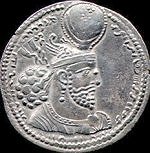 |
276 | 293 | Son |
|
|||||
| 6 | Bahram III Bahram III Bahram III was the sixth Sassanid King of Persia and son of Bahram II. He was appointed viceroy to the region of Sakasthan after Bahram II's conquest of it sometime in the 280's CE.... |
293 | 293 | Son |
|
||||||
| 7 | Narseh Narseh Narseh was the seventh Sassanid King of Persia , and son of Shapur I .... |
 |
293 | 302 | Grand-uncle |
|
|||||
| 8 | Hormizd II Hormizd II Hormizd II, was the eighth Persian king of the Sassanid Empire, and reigned for seven years and five months, from 302 to 309. He was the son of Narseh .Almost nothing is known of his reign... |
302 | 309 | Son |
|
||||||
| 9 | Adarnases | 309 | 309 | Unknown |
|
||||||
| 10 | Shapur II Shapur II Shapur II the Great was the ninth King of the Persian Sassanid Empire from 309 to 379 and son of Hormizd II. During his long reign, the Sassanid Empire saw its first golden era since the reign of Shapur I... |
309 | 379 | Brother |
|
||||||
| 11 | Ardashir II Ardashir II Ardashir II was the tenth Sassanid King of Persia from 379 to 383.He is believed by some to be the son and by others to be the brother of his predecessor, Shapur II... |
379 | 383 | Brother or son |
|
||||||
| 12 | Shapur III Shapur III Shapur III was the eleventh Sassanid King of Persia from 383 to 388. Shapur III succeeded his father Ardashir II in the year 383.- Treaty with Rome :... |
383 | 388 | Brother | |||||||
| 13 | Bahram IV Bahram IV Bahram IV was twelfth Sassanid King of Persia , son and successor of Shapur III of Persia , under whom he had been governor of Kerman; therefore he was called Kermanshah Bahram IV was twelfth Sassanid King of Persia (388–399), son and successor of Shapur III of Persia (383–388), under whom he had... |
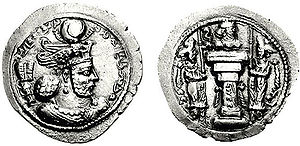 |
388 | 399 | Son | ||||||
| 14 | Yazdegerd I Yazdegerd I Yazdegerd I, or Izdekerti , was the thirteenth Sassanid king of Persia and ruled from 399 to 421. He is believed by some to be the son of Shapur III and by others to be son of Bahram IV... |
399 | 420 | Son | |||||||
| 15 | Bahram V Bahram V Bahram V was the fourteenth Sassanid King of Persia . Also called Bahram Gur or Bahramgur , he was a son of Yazdegerd I , after whose sudden death he gained the crown against the opposition of the grandees by the help of Mundhir, the Arab dynast of al-Hirah.- Reign and war with Rome :Bahram V... |
420 | 438 | Son | |||||||
| 16 | Yazdegerd II Yazdegerd II Yazdegerd II was the fifteenth Sassanid King of Persia. He was the son of Bahram V and reigned from 438 to 457.... |
438 | 457 | Son | |||||||
| 17 | Hormizd III Hormizd III Hormizd III, sixteenth Sassanid King of Persia, son of Yazdegerd II , succeeded his father in 457.Hormizd, the older son of Yazdegerd II, was kept near Ctesiphon, while his younger brother, Peroz, was stationed in Sistan. Following his father's death, Hormizd became ruler of the Sassanian Empire... |
457 | 459 | Son | |||||||
| 18 | Peroz I Peroz I Peroz I Peroz I Peroz I (also Pirooz; Peirozes (Priscus, fr. 33); Perozes (Procopius, De Bello Pers. I. 3 and Agathias iv. 27; the modern form of the name is Perooz, Piruz, or the Arabized Ferooz, Firuz; Persian: پیروز "the Victor"), was the seventeenth Sassanid King of Persia, who ruled from 457... |
457 | 484 | Brother | |||||||
| 19 | Balash Balash Balash , the eighteenth Sassanid King of Persia in 484–488, was the brother and successor of Peroz I of Persia , who had died in a battle against the Hephthalites who invaded Persia from the east.- Reign of Balash :Balash was made King of Persia following the death of his... |
484 | 488 | Brother |
Zareh Zareh is an Armenian given name, derived from a legendary king mentioned in chapter 1.31 of the History of Armenia.... , but he was unsuccessful and executed Kavadh Kavadh may refer to:*Kavadh I of Persia *Kavadh II of Persia, 7th century... , who at first unsuccessful requested help from Hephthalites |
||||||
| 20 | Kavadh I Kavadh I Kavad or Kavadh I was the son of Peroz I and the nineteenth Sassanid king of Persia, reigning from 488 to 531... |
 |
488 | 531 | Uncle |
|
|||||
| 21 | Djamasp Djamasp Djamasp was a Sassanid king who ruled from 496 to 498. He was a younger brother of king Kavadh I and was installed on the Sassanid throne upon the deposition of the latter by members of the nobility.... |
496 | 498 | Brother | |||||||
| 22 | Khosrau I Khosrau I Khosrau I , also known as Anushiravan the Just or Anushirawan the Just Khosrau I (also called Chosroes I in classical sources, most commonly known in Persian as Anushirvan or Anushirwan, Persian: انوشيروان meaning the immortal soul), also known as Anushiravan the Just or Anushirawan the Just... |
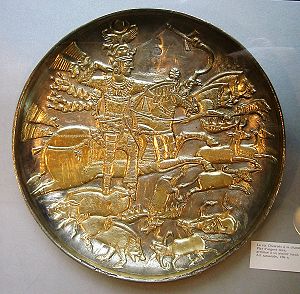 |
531 | 579 | Son | ||||||
| 23 | Hormizd IV Hormizd IV Hormizd IV, son of Khosrau I, reigned as the twenty-first King of Persia from 579 to 590.He seems to have been imperious and violent, but not without some kindness of heart. Some very characteristic stories are told of him by Tabari. His father's sympathies had been with the nobles and the priests... |
 |
579 | 590 | Son | ||||||
| 24 | Bahrām Chobin Bahram Chobin General Bahrām Chobin was a famous Eran spahbod during the late 6th century in Persia, usurping the Sassanid throne for a year as Bahram VI .- Life :... |
590 | 591 | Rebel |
|
||||||
| 25 | Bistam | 591 | 595 | Uncle |
|
||||||
| 26 | Hormizd V Hormizd V Hormizd V was briefly the ruler of the Sassanid Empire. Described as a usurper, he was one of many pretenders who rose after the temporary deposition of Chosroes II by Bahram Chobin.... |
593 | 593 | Unknown | |||||||
| 27 | Khosrau II Khosrau II 250px|thumb|Khosrau II 250px|thumb|Khosrau II 250px|thumb|Khosrau II (Khosrow II, Chosroes II, or Xosrov II in classical sources, sometimes called Parvez, "the Ever Victorious" – (in Persian: خسرو پرویز), was the twenty-second Sassanid King of Persia, reigning from 590 to 628... |
591 | 628 | Son | |||||||
| 28 | Kavadh II Kavadh II Kavadh II , twenty-third Sassanid King of Persia, son of Khosrau II , was raised to the throne in opposition to his father in February 628, after the great victories of the Emperor Heraclius... |
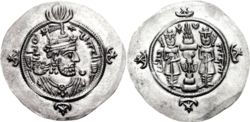 |
628 | 628 | Son |
|
|||||
| 29 | Ardashir III Ardashir III Ardashir III was the twenty-fourth Sassanid King of Persia from 628 to 630.He was a son of Kavadh II/Shiroes and "Anzoy the Roman". His mother was probably from the Byzantine Empire. He was raised to the throne as a boy of seven years, but was killed 18 months later by his general, Shahrbaraz .-... |
 |
628 | 630 | Son | ||||||
| 30 | Shahrbaraz Shahrbaraz Shahrbaraz or Shahrwaraz was a general, with the rank of Eran Spahbod under Khosrau II . His name was Farrokhan, and Shahrbaraz was his title... |
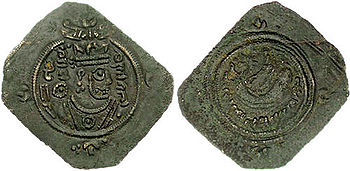 |
630 | 630 | General | ||||||
| 31 | Borandukht | 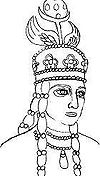 |
630 | 631 | Daughter |
Khosrau II 250px|thumb|Khosrau II 250px|thumb|Khosrau II 250px|thumb|Khosrau II (Khosrow II, Chosroes II, or Xosrov II in classical sources, sometimes called Parvez, "the Ever Victorious" – (in Persian: خسرو پرویز), was the twenty-second Sassanid King of Persia, reigning from 590 to 628... |
|||||
| 32 | Azarmidokht Azarmidokht Azarmidokht was the twenty-seventh Sassanid Monarch of Persia, and daughter of Khosrau II. She ruled Persia after her sister Purandokht.After the death of her father Khosrau II anarchy spread in the Sassanid empire. The subsequent rulers could stay for only a relatively brief time on the throne,... |
631 | 631 | Daughter |
|- |
33 | > | 631 | 631 | Unknown | |
| 34 | Hormizd VI Hormizd VI Hormizd VI or V, twenty-eighth Sassanid King of Persia, was one of the many pretenders who rose after the murder of Khosrau II in 628. He maintained himself about two years in the district of Nisibis. There was also a brief usurper king, not always numbered among the monarchs, called Hormizd V in... |
631 | 632 | Usurper | |||||||
| 35 | Yazdegerd III | 632 | 651 | Unknown |
|
||||||
| Destruction of the Sassanid dynasty | |||||||||||
| - | Peroz II | 631 (In exile) | 631 (In exile) | Son |
|
||||||
| - | Narsieh Narsieh Narsieh was a Persian-Chinese general stationed in the Tang military garrison. He was son of prince Peroz III and grandson of Yazdgerd III, the last Sassanid king of Persia.... |
Unknown | Unknown | Son |
|
||||||

